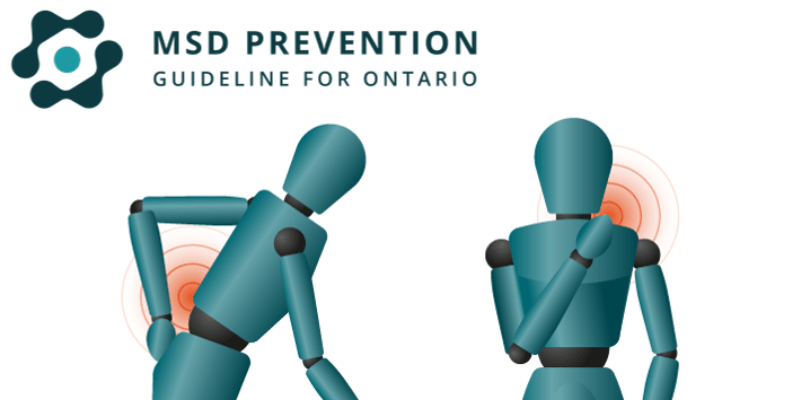Enhance workplace safety with CRE-MSD's updated MSD Prevention Guidelines

Musculoskeletal disorders (MSDs) are a common workplace hazard that should be top of mind for Ontario businesses. These injuries of the muscles, tendons, ligaments, bones, and nerves are the most frequent cause of injury claims in Ontario. Not only are they one of the largest contributors to lost time claim costs, but they also take a financial toll, with sprains and strains alone accounting for 38% of all WSIB claims in 2023, amounting to a staggering direct cost of $115,600,641. The low back is the most commonly affected area, followed by the shoulders. The neck, elbows, hands, and wrists are also common.
To help workplaces address these injuries, The Centre of Research Expertise for the Prevention of Musculoskeletal Disorders (CRE-MSD) has redeveloped the Ontario MSD Prevention Guideline to help employers tackle MSDs in their workplaces.
CRE-MSD, which is affiliated with the University of Waterloo and funded by the Ministry of Labour, Immigration, Training and Skills Development, redesigned the Ontario MSD Prevention Guideline website to improve navigation and accessibility. “Our goal with this update was to make the website a more user-centred and easier-to-use platform,” explains Jacklyn Kurt, Ergonomics Research Coordinator with CRE-MSD.
Designed for workers and employers
While the original Ontario MSD Prevention Guideline contained a wealth of valuable information, feedback from users indicated that it was difficult to find the resources they were looking for. The redeveloped guideline addresses that problem. “To help people quickly find what they need, we created worker-centered pages to bring people directly to what is most relevant to them,” says Jacklyn.
Jacklyn explains that the top navigation of the website lists the following categories:
- I perform work
- I supervise workers
- I represent workers
- I manage workers
- I evaluate and/or design work, and
- I support and/or care for workers.
When you select the option that best describes what you do, you are immediately taken to a page that pulls out the most relevant resources from the Guideline for your role,” says Jacklyn. She points out that this is particularly helpful for people who may not know exactly what they need. “This feature saves a lot of time,” she says.
Making the website more visual was another focus of the redevelopment. When you visit the Ontario MSD Prevention Guideline website you will now find detailed diagrams, images, posters, and videos. These visual resources were added to improve the accessibility and understanding of key concepts. They clearly illustrate right/wrong examples of how to perform common tasks and walk workers through proper movement patterns.
6 new features of the updated website
Get started by checking out these six features on the new MSD Prevention Guideline website.
- Guideline Selector - There are four different MSD Prevention Guidelines. The Guideline Selector is a tool that helps people determine which guideline is most applicable to where they are in their MSD prevention journey. “The Guideline Selector asks a few questions about your organization, such as how many employees you have and what type of work they do. Then, it directs you to the specific Guideline that corresponds to your needs,” explains Jacklyn.
- Quick Start Guidelines - These visual guides provide workers and employers with practical things they can start doing right away to reduce their risk of developing an MSD. Use them to kickstart your MSD prevention program.
- Types of MSD (Interactive Diagram) - This diagram is an engaging way for people to become more familiar with specific MSD injuries and their symptoms. When you click various parts of the body, you learn which MSD are associated with that area. It’s a perfect resource for a health and safety meeting.
- What is an MSD? Introductory Video - This video is ideal for new worker orientation. Make it a component of your onboarding training or health and safety meeting. It explains the signs and symptoms of MSD.
- Health and Safety Program Poster - Learn how to integrate each step of the Guideline into your existing health and safety program by following the framework outlined in this resource.
- Cost-benefit Calculator - If your organization is considering implementing a specific control to reduce MSD risk, use this cost-benefit calculator to determine the most cost-effective way. The calculator compares different ergonomic interventions with cost estimates and payback periods.
How WSPS can help
WSPS has experts and free resources to help you implement the controls and strategies outlined in the MSD Prevention Guideline.
Consulting
Connect with a WSPS ergonomist to identify MSD hazards in your workplace and explore control options.
Resources
- MSD Hazards Checklist
- How can workers identify lift hazards? (video)
- MLITSD material handling inspections on now: be prepared
- Five evidence-based tools and initiatives focused on ergonomics
- Safe Lifting: 10 tips and videos
- Business in Motion: Managing Material Hazards
Training
- MSD Prevention Awareness (1 hour, eCourse)
- Office Ergonomics Assessment (1 day, Online Instructor-Led Training)
- Safe Lifting and Manual Materials Handling (0.5 days, Online Instructor-Led Training)
The information in this article is accurate as of its publication date.




